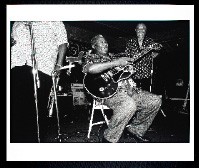Some of the people portrayed in “American Music,” the exhibition of Annie Leibovitz photographs that opens at the Memphis Brooks Museum of Art on Friday, June 2nd, are thin. Some of them are fat. They are white, black, or brown, with hair that’s blond, brunette, red, or silver, shorn off or coiffed in pompadours, processes, braids, or shimmering, loose cascades.
To quote Susan Orlean, in her essay “All Mixed Up,” “these musicians play piano, guitar, drums, or bass. Some are captured on street corners, microphone in hand. Others sit in front of recording studio control boards, or pose backstage, onstage, or, in the case of former Beach Boy Brian Wilson, poolside. They face towards the camera, or lean away from the camera, caught mid-puff or mid-note.”
Leibovitz’s iconic photographs, taken for Vanity Fair magazine and the Experience Museum Project, were shot between 1999 and 2002.
She found her subjects in Texas, Louisiana, Florida, California, New York, New Jersey, and Missouri. Rappers Nelly, Missy Elliott, and Run D.M.C. were photographed in New York City, while soul singer Irma Thomas was shot in New Orleans.
In north Mississippi, Leibovitz photographed blues veterans like R.L. Burnside, Jessie Mae Hemphill, and Othar Turner, as well as the next generation of talent, including Cedric Burnside, Garry Burnside, Kinney Kimbrough, and the North Mississippi Allstars. In Memphis, she wandered through a deserted Graceland, shot Aretha Franklin’s childhood home, and captured a reunion of Stax Records employees at the intersection of College Street and McLemore Avenue.
“I was honored,” North Mississippi Allstars guitarist Luther Dickinson says of the camera’s scrutiny, “although I had to overcome my pimple!”
Looking back at the portrait, shot in 2000, when the Allstars were just beginning their career, Dickinson notes that “me, Chris [Chew, the group’s bassist], and Cody [Dickinson, the drummer] were just trying to do something with our lives. It’s strange to think that we’ll never have that perspective again.”
For Deanie Parker, CEO of Soulsville U.S.A., the nonprofit behind the Stax Museum of American Soul Music, Leibovitz’ decision to shoot the Stax alumni in 2002 was both timely and fortuitous:

“When Vanity Fair first contacted us, we were attempting to complete both the museum and the Stax Music Academy, and [the photo] helped create an exciting crescendo for the entire project. I’m glad we were fortunate enough to do it while Estelle [Axton, co-founder of Stax Records] was still living.
“The fact that they had Ms. Leibovitz as the photographer was the ultimate compliment,” Parker adds. “I’d heard about her, and I’d seen her work, but I’d never seen her work.”
The wide-angle portrait, which Parker calls “the most phenomenal photograph I’ve seen in my life,” shows a family of graying musicians, black and white. Mavis Staples leans in to hug her sister, Yvonne. Nearby, a regal Carla Thomas stands arm-in-arm with Eddie Floyd. Steve Cropper, Duck Dunn, and Booker T. Jones hover at one edge of the image, while the songwriting team of Isaac Hayes and David Porter anchor the other. A steadfast Axton is the planet that everyone orbits around, including the curious neighborhood kids who rode up on bicycles to witness the spectacle.
“[Leibovitz] studied it for I don’t know how long,” remembers Parker. “She dwelled on it, and then she created the picture. She selectively chose and strategically placed everyone so that the viewer could really live vicariously through her eyes. She must’ve taken tons and tons of photographs that day, but she knew what she was looking for.
“Annie Leibovitz created a mood,” Parker says, “and via a very spiritual experience, she shared with us how she truly felt about Stax Records.”
Then, with a giggle, Parker explains that she woke up early the day of the shoot and wound hot rollers in her hair. After arriving at the site, she removed the rollers and carefully patted her curls into place, despite the humidity.
“Lo and behold,” she says, “after the woman got us all positioned, she turned on a two-ton fan. Talk about a windblown look — it was the funniest thing I think I’ve ever experienced!
“Still, I want her to know that she’s always welcome here. She has earned her place in this Soulsville family. Her love for the subject that she photographed says wonders about her love for the music that came from the corner of College and McLemore, as well as her love for the people. She captured the magic.”